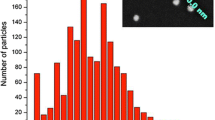Abstract
Quantum dots (QDs) and silica nanoparticles (SNs) are relatively new classes of fluorescent probes that overcome the limitations encountered by organic fluorophores in bioassay and biological imaging applications. We encapsulated QDs and SNs in liposomes and separated nanoparticle-loaded liposomes from unencapsulated nanoparticles by size exclusion chromatography. Fluorescence correlation spectroscopy was used to measure the average number of nanoparticles inside each liposome. Results indicated that nanoparticle-loaded liposomes were formed and separated from unencapsulated nanoparticles by using a Sepharose gel. As expected, fluorescence self-quenching of nanoparticles inside liposomes was not observed. Each liposome encapsulated an average of three QDs. These studies demonstrated that nanoparticles could be successfully encapsulated into liposomes and provided a methodology to quantify the number of nanoparticles inside each liposome by fluorescence correlation spectroscopy.
Similar content being viewed by others
References
Ahn-Yoon S., DeCory T.R., Baeumner A.J., Durst R.A., (2003). Ganglioside-liposome immunoassay for the ultrasensitive detection of cholera toxin. Anal. Chem. 75:2256–2261
Alivisatos A.P., (1996). Semiconductor clusters, nanocrystals, and quantum dots. Science 271:933–937
Baeumner A. J., Pretz J., Fang S., (2004). A universal nucleic acid sequence biosensor with nanomolar detection limits. Anal. Chem. 76:888–894
Barber K., Mala R. R., Lambert M. P., Qiu R. Z., MacDonald R. C., Klein W. L., (1996). Delivery of membrane-impermeant fluorescent probes into living neural cell populations by lipotransfer. Neurosci. Lett. 207:17–20
Chan W. C., Nie S., (1998). Quantum dot bioconjugates for ultrasensitive nonisotopic detection. Science 281:2016–2018
Diederichs J. E., (1996). Plasma protein adsorption patterns on liposomes: establishment of analytical procedure. Electrophoresis 17:607–611
Esch M. B., Baeumner A. J., Durst R. A., (2001). Detection of Cryptosporidium parvum using oligonucleotide-tagged liposomes in a competitive assay format. Anal. Chem. 73:3162–3167
Goldman E. R., Anderson G. P., Tran P. T., Mattoussi H., Charles P. T., Mauro J. M., (2002). Conjugation of luminescent quantum dots with antibodies using an engineered adaptor protein to provide new reagents for fluoroimmunoassays. Anal. Chem. 74:841–847
Ho J. A., Hsu H. W., Huang M. R., (2004). Liposome-based microcapillary immunosensor for detection of Escherichia coli O157:H7. Anal. Biochem. 330:342–349
Kim S. A., Schwille P., (2003). Intracellular applications of fluorescence correlation spectroscopy: prospects for neuroscience. Curr. Opin. Neurobiol. 13:583–590
Larson D. R., Heikal A., Ow H., Srivastava M., Wiesner U., Baird B., Webb W. W., (2003a). Development of fluorescent silica nanoparticles for biological imaging. Biophys. J. 84:586A–586A
Larson D. R., Zipfel W. R., Williams R. M., Clark S. W., Bruchez M. P., Wise F. W., Webb W. W., (2003b). Water-soluble quantum dots for multiphoton fluorescence imaging in vivo. Science 300:1434–1436
Levin M. K., Carson J. H., (2004). Fluorescence correlation spectroscopy and quantitative cell biology. Differentiation 72:1–10
Maiti S., Haupts U., Webb W. W., (1997). Fluorescence correlation spectroscopy: diagnostics for sparse molecules. Proc. Natl. Acad. Sci. USA 94:11753–11757
Mattoussi H., Radzilowski L. H., Dabbousi B. O., Thomas E. L., Bawendi M. G., Rubner M. F., (1998). Electroluminescence from heterostructures of poly(phenylene vinylene) and inorganic CdSe nanocrystals. J. Appl. Phys. 83:7965–7974
Muller W. J., Zen K., Fisher A. B., Shuman H., (1995). Pathways for Uptake of Fluorescently Labeled Liposomes by Alveolar Type-Ii Cells in Culture. Am. J. Physiol. Lung Cell Mol. Physiol. 13:L11–L19
Park S., Durst R. A., (2000). Immunoliposome sandwich assay for the detection of Escherichia coli O157:H7. Anal. Biochem. 280:151–158
Reynolds J. A., Nozaki Y., Tanford C., (1983). Gel-exclusion chromatography on S1000 Sephacryl: application to phospholipid vesicles. Anal. Biochem. 130:471–474
Rigler R., (1995). Fluorescence correlations, single molecule detection and large number screening. Applications in biotechnology. J Biotechnol 41:177–186
Rodriguez-Viejo J., Mattoussi H., Heine J. R., Kuno M. K., Michel J., Bawendi M. G., Jensen K. F., (2000). Evidence of photo- and electrodarkening of (CdSe)ZnS quantum dot composites. J. Appl. Phys. 87:8526–8534
Schrock E., du Manoir S., Veldman T., Schoell B., Wienberg J., Ferguson-Smith M. A., Ning Y., Ledbetter D. H., Bar-Am I., Soenksen D., Garini Y., Ried T., (1996). Multicolor spectral karyotyping of human chromosomes. Science 273:494–497
Siebert S. T. A., Reeves S. G., Durst R. A., (1993). Liposome immunomigration field assay device for Alachlor determination. Anal. Chim. Acta 282:297–305
Stober, W., A. Fink & E. Bohn, 1968. Controlled growth of monodisperse silica spheres in micron size range. J. Colloid Interf. Sci. 26, 62.
Struck D. K., Pagano R. E., (1980). Insertion of fluorescent phospholipids into the plasma-membrane of a mammalian-cell. J. Biol. Chem. 255:5404–5410
Trau D., Yang W., Seydack M., Caruso F., Yu N. T., Renneberg R., (2002). Nanoencapsulated microcrystalline particles for superamplified biochemical assays. Anal. Chem. 74:5480–5486
Yang W., Zhang C. G., Qu H. Y., Yang H. H., Xu J. G., (2004). Novel fluorescent silica nanoparticle probe for ultrasensitive immunoassays. Anal. Chim. Acta 503:163–169
Author information
Authors and Affiliations
Corresponding author
Rights and permissions
About this article
Cite this article
Chen, CS., Yao, J. & Durst, R.A. Liposome encapsulation of fluorescent nanoparticles: Quantum dots and silica nanoparticles. J Nanopart Res 8, 1033–1038 (2006). https://doi.org/10.1007/s11051-006-9142-1
Received:
Accepted:
Published:
Issue Date:
DOI: https://doi.org/10.1007/s11051-006-9142-1




